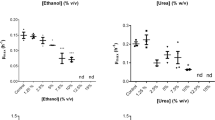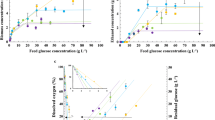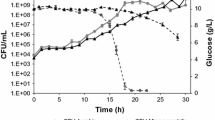Abstract
Saccharomyces cerevisiae was grown in a chemostat under glucose limitation at three superoptimal temperatures. In each steady state the specific growth rate was the sum of the dilution rate and the specific death rate, exponential death concurring with exponential growth. The specific death rate was a function of the temperature while the specific growth rate was a function of both the temperature and the concentration of the limiting nutrient. Each superoptimal temperature was characterized by a critical glucose concentration below which net growth was not possible. The critical glucose concentration increased with the temperature. Consequently the maximum temperature for growth was a function of the concentration of the limiting nutrient and approached the optimum temperature for growth with decreasing glucose concentrations.
Similar content being viewed by others
References
Bergmeyer, H. U., Bent, E.: d-Glucose, Bestimmung mit Glucose-Oxydase und Peroxydase. In: Methoden der Enzymatischen Analyse, H. U. Bergmeyer, ed., p. 123. Weinheim: Verlag Chemie 1962
Duursma, E. K.: Dissolved organic carbon, nitrogen and phosphorus in the seas. Neth. J. mar. Res. 1, 1–148 (1960)
Monod, J.: Recherches sur la croissance des cultures bactériennes. Paris: Herman 1942
Oliveira-Baptista, A., van Uden, N.: Occurrence of two maximum temperatures for growth in yeasts. Z. allg. Mikrobiol. 11, 59–61 (1971)
Sokal, R. R., Rohlf, F. J.: Biometry. San Francisco: Freeman and Company 1969
van Uden, N.: Transport-limited fermentation and growth of Saccharomyces cerevisiae and its competitive inhibition. Arch. Mikrobiol. 58, 155–168 (1967)
van Uden, N.: Growth in the chemostat at superoptimal temperatures: a theoretical treatment. In: Continuous cultivation of microorganisms, I. Malek, ed., pp. 49–58. Prague: Academia 1969a
van Uden, N.: Kinetics of nutrient-limited growth. Ann. Rev. Microbiol. 23, 473–486 (1969b)
van Uden, N., Abranches, P., Cabeca-Silva, C.: Temperature functions of thermal death in yeasts and their relation to the maximum temperature for growth. Arch. Mikrobiol. 61, 381–393 (1968)
van Uden, N., Fell, J. W.: Marine yeasts. In: Adv. microbiol. of the sea, M. R. Droop, E. J. Ferguson Wood, eds., pp. 167–201. New York: Academic Press 1968
van Uden, N., Madeira-Lopes, A.: Concurrent exponential growth and death of cell populations of Saccharomyces cerevisiae at superoptimal growth temperatures. Z. allg. Mikrobiol. 10, 515–526 (1970)
Author information
Authors and Affiliations
Rights and permissions
About this article
Cite this article
Van Uden, N., Madeira-Lopes, A. Dependence of the maximum temperature for growth of Saccharomyces cerevisiae on nutrient concentration. Arch. Microbiol. 104, 23–28 (1975). https://doi.org/10.1007/BF00447295
Received:
Issue Date:
DOI: https://doi.org/10.1007/BF00447295




